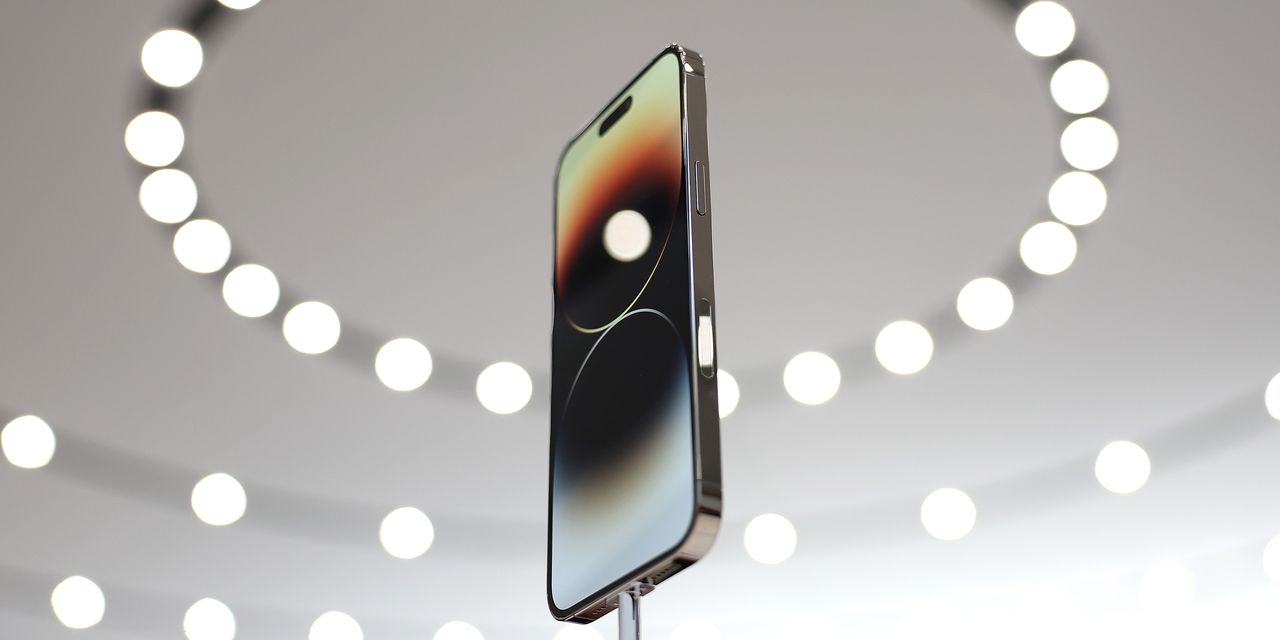Apple
hasn’t been feeling Wall Street’s love the past couple of days—since it reported earnings—and understandably so, even though the launch of iPhone 15 is about a month away.
The snub started in late trading Thursday, after Apple (ticker: AAPL) beat analysts’ earnings expectations by 6 cents—$1.26 a share for the June quarter—but showed a sales decline of 1% year over year.
By Friday’s closing bell, the stock had dropped below its $3 trillion market capitalization. The losses—4.8%, to the price of $181.99—were the biggest in a single day since Sept. 29. And it was the first time since early this year that shares closed below their 50-day moving average of $187.09.
On Monday, the picture didn’t improve. Shares dropped 1.7%, to $178.76, making Apple the poorest performer in the
Dow Jones Industrial Average.
For those who don’t track Apple stock closely, it’s hard to fathom that a slight sales drop would shake investors. After all, they have enjoyed an annualized total return of 29% over the past decade, compared with 12% for the
S&P 500
and 11% for the Dow.
But devotees of the tech titan know that sales have declined on a year-over-year basis for three quarters, the first since the three quarters ending September 2016. And Apple was the only one among its rivals to report a fall in revenue between consecutive quarters in this latest earnings season.
Plus, the company expects its performance to be similar in the current September quarter, assuming the broad economic outlook doesn’t get worse.
The problem: Fewer customers are willing to buy the next Apple product. During an earnings conference call on Thursday, management said the U.S. smartphone market has been in a decline for the last couple of quarters and noted a 2.4% hit to iPhone sales in the June quarter. Revenue from iPad and Mac sales dropped about 20% and 7%, respectively, from a year ago.
Apple’s report “highlights the slowdown phase in which Apple now sits,” wrote Rosenblatt Securities analyst Barton Crockett, in a note on Friday. He downgraded the stock to Neutral from Buy but maintained his $198 price target.
Microsoft
(MSFT) knows Apple’s pain. Its product sales fell 6.1% in the latest quarter, wrote DataTrek Research’s co-founder Nicholas Colas on Monday. But
Microsoft
made up the loss with growth in its services, up 16% from a year ago. Apple showed 8.2% growth in services.
For Apple, the heat is on to keep boosting services. But the big pressure really is to deliver with solid iPhone sales in the coming quarters to allay worries of a slowing smartphone market, particularly in developed regions.
UBS analyst David Vogt forecasts 49 million iPhone units to be sold in the current quarter, unchanged from the same quarter a year ago. Management expects year-year performance for the iPhone to accelerate in the September quarter.
But the real opportunity lies with the iPhone 15, which is slated to hit stores on Sept. 22, Bloomberg reported. That makes the holiday quarter, which ends Dec. 31, the one to watch. Apple didn’t respond to a Barron’s request to verify the date.
Apple will face an easy comparison with the same period in 2022, which was hit by supply chain disruptions, but a challenge in the December quarter will be swings in the exchange rate in India and other big foreign markets. Currency moves have lowered Apple’s overseas revenue in recent quarters.
Weak sales of the iPhone aside, investors are hanging back because the stock is just downright expensive. It trades at 28 times its next 12 months earnings, higher than its five-year average price-to-earnings ratio of 23.2 and well ahead of its lowest price-to-earnings ratio of 10.8.
It’s now on Apple to convince investors to splurge.
Write to Karishma Vanjani at [email protected]
Read the full article here





